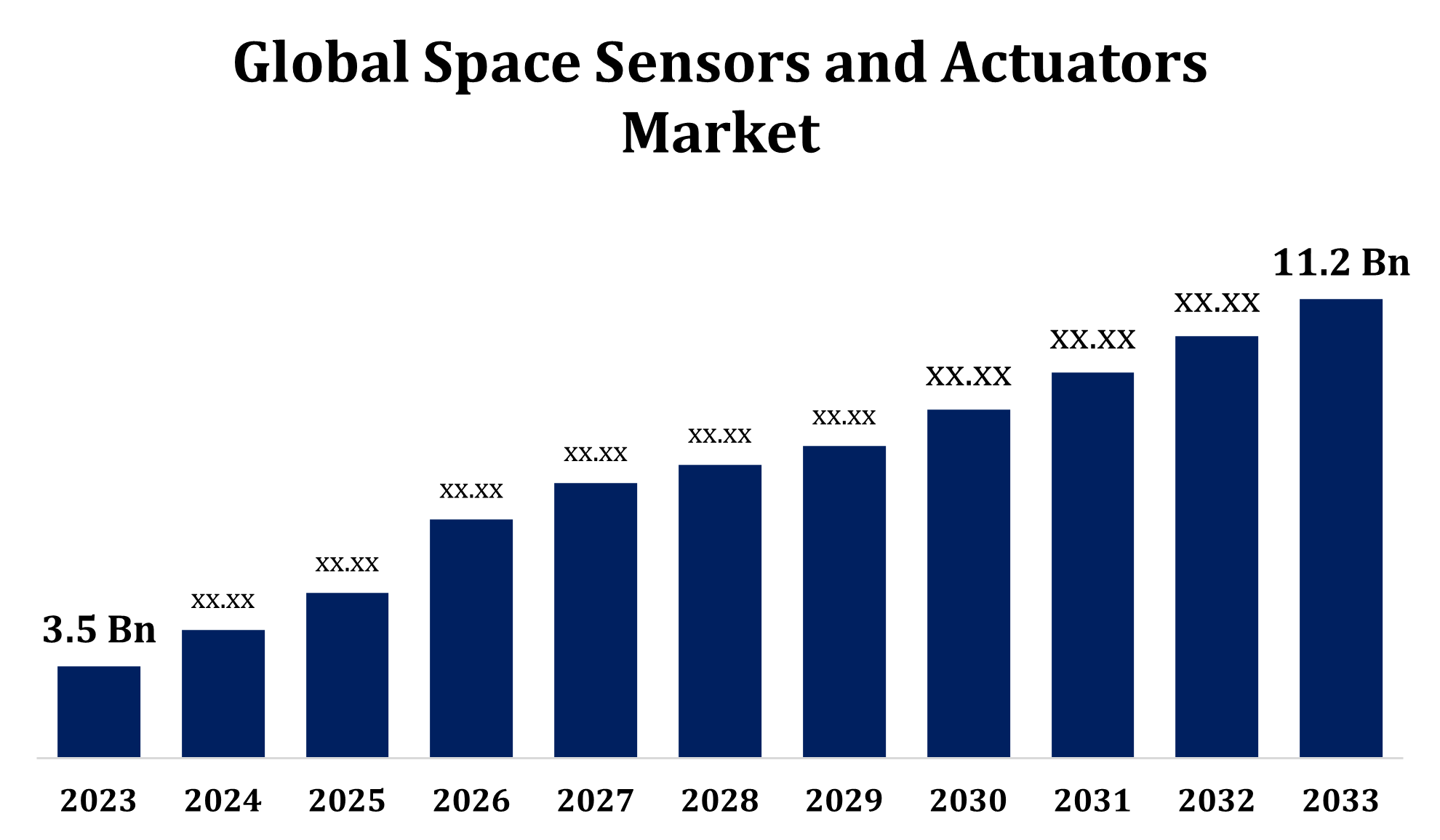Global Space Sensors and Actuators Market Size, Share, and COVID-19 Impact Analysis, By Type (Sensors, Actuators), By Application (Satellite Systems, Space Exploration, Launch Vehicles, Robotic Spacecraft, Ground Control Systems), By End Use (Government, Commercial, Research Institutions, Defense), and By Region (North America, Europe, Asia-Pacific, Latin America, Middle East, and Africa), Analysis and Forecast 2023 - 2033
Industry: Aerospace & DefenseGlobal Space Sensors and Actuators Market Insights Forecasts to 2033
- The Space Sensors and Actuators Market Size was valued at USD 3.5 billion in 2023.
- The Market Size is Growing at a CAGR of 12.33% from 2023 to 2033.
- The Worldwide Space Sensors and Actuators Market Size is expected to reach USD 11.2 billion by 2033.
- Asia Pacific is expected to grow the fastest during the forecast period.

Get more details on this report -
The global Space Sensors and Actuators Market is expected to reach USD 11.2 billion by 2033, at a CAGR of 12.33% during the forecast period 2023 to 2033.
The space sensors and actuators market is driven by the growing demand for advanced space exploration and satellite technologies. Sensors, such as temperature, pressure, and radiation detectors, play a crucial role in space missions by ensuring the monitoring and management of various spacecraft systems. Actuators, responsible for controlling movement, stabilization, and positioning, are equally important in space applications. With an increase in satellite launches, space tourism, and deep space exploration, the market is poised for significant growth. Innovations in miniaturization and the development of more reliable and cost-effective solutions are enhancing the performance and efficiency of space systems. Additionally, government and private sector investments in space infrastructure are expected to further boost market expansion, particularly in satellite communication and scientific research missions.
Space Sensors and Actuators Market Value Chain Analysis
The space sensors and actuators market value chain begins with raw material suppliers, providing components like metals, semiconductors, and specialized materials. Manufacturers then design and produce the sensors and actuators, incorporating advanced technologies such as micro-electromechanical systems (MEMS) and piezoelectric materials. These components undergo rigorous testing and integration for reliability in space conditions. The next stage involves system integrators, who combine sensors and actuators with other spacecraft systems, ensuring compatibility with mission requirements. Launch service providers transport the final space-ready systems to orbit, while ground control teams monitor and manage performance throughout the mission. Throughout the value chain, research and development play a crucial role in driving innovation, while governments, aerospace agencies, and private firms influence demand through funding and project initiatives.
Space Sensors and Actuators Market Opportunity Analysis
The space sensors and actuators market presents significant opportunities driven by expanding space missions, satellite constellations, and emerging commercial space activities. Increasing demand for high-performance, miniaturized sensors and actuators for applications such as satellite communication, Earth observation, and space exploration fuels growth. Advancements in micro-electromechanical systems (MEMS) and smart materials open new avenues for creating more efficient, cost-effective solutions. Moreover, the rise of private companies entering the space industry, coupled with government initiatives in space exploration, particularly Mars missions and space tourism, further intensify the market’s potential. Additionally, the need for advanced sensors and actuators in next-gen space vehicles and deep space missions offers opportunities for innovation. As space technologies evolve, there’s room for strategic investments, collaborations, and the development of next-generation solutions tailored to specific space mission requirements.
Global Space Sensors and Actuators Market Report Coverage
| Report Coverage | Details |
|---|---|
| Base Year: | 2023 |
| Market Size in 2023: | USD 3.5 Billion |
| Forecast Period: | 2023-2033 |
| Forecast Period CAGR 2023-2033 : | 12.33% |
| 2033 Value Projection: | USD 11.2 Billion |
| Historical Data for: | 2019-2022 |
| No. of Pages: | 220 |
| Tables, Charts & Figures: | 100 |
| Segments covered: | By Type, By Application, By End Use, By Region |
| Companies covered:: | MOOG, Lockheed Martin, L3Harris Technologies, Honeywell, Airbus, SAAB, Sierra Nevada Corporation, Aerojet Rocketdyne, Maxar Technologies, Raytheon Technologies, Boeing, Teledyne Technologies, Ball Aerospace, Thales Group, Northrop Grumman. |
| Pitfalls & Challenges: | Covid-19 Impact, Challenge, Future,Growth and Analysis |
Get more details on this report -
Market Dynamics
Space Sensors and Actuators Market Dynamics
Increase in satellite launches and constellation initiatives
The growth of the space sensors and actuators market is significantly influenced by the increase in satellite launches and constellation initiatives. As more satellites are deployed for communication, Earth observation, and scientific research, the demand for advanced sensors and actuators to ensure their proper functioning has surged. These technologies are crucial for monitoring spacecraft health, managing power, temperature, and positioning systems, and ensuring mission success. Constellation projects, involving large groups of small satellites operating in synergy, further drive the need for robust, miniaturized, and high-performance sensors and actuators. The growing number of satellite missions by both government and private sectors creates a substantial market opportunity, prompting innovations in sensor accuracy, actuator efficiency, and system integration to support these expanding satellite networks.
Restraints & Challenges
Components must withstand extreme temperatures, radiation, and vacuum conditions, requiring high reliability and durability. Additionally, the high cost of manufacturing space-grade sensors and actuators limits accessibility for smaller space missions and private companies. Another challenge is the need for miniaturization, as space systems demand increasingly compact yet powerful technologies, which can complicate design and integration processes. The long development timelines for space missions and regulatory hurdles also contribute to delays in product deployment. Moreover, the complexity of system integration, especially in satellite constellations, increases the risk of failure. Overcoming these challenges requires continuous innovation, rigorous testing, and strategic collaboration between industry stakeholders.
Regional Forecasts
North America Market Statistics

Get more details on this report -
North America is anticipated to dominate the Space Sensors and Actuators Market from 2023 to 2033. The U.S. government’s focus on space exploration, satellite communication, and national security, coupled with increasing commercial space activities, fuels demand for advanced sensors and actuators. The region also benefits from a robust aerospace industry, which leads in research and development of cutting-edge technologies such as micro-electromechanical systems (MEMS) and smart materials. Furthermore, North America's well-established supply chain, along with an innovative ecosystem of manufacturers, system integrators, and service providers, strengthens its market position. The increasing number of satellite constellations and space missions in the region will continue to drive market growth in the coming years.
Asia Pacific Market Statistics
Asia Pacific is witnessing the fastest market growth between 2023 to 2033. China, India, and Japan are at the forefront of space exploration, satellite communication, and Earth observation, creating a growing demand for high-performance sensors and actuators. India’s expanding space programs, including satellite constellations and interplanetary missions, are major contributors to this demand. Similarly, China's ambitious space exploration goals and Japan’s advancements in space robotics drive the need for innovative, miniaturized components. The rise of private space ventures in the region further stimulates market growth. As Asia Pacific continues to enhance its space infrastructure, the demand for reliable, cost-effective, and efficient sensors and actuators will increase, presenting new opportunities for market expansion.
Segmentation Analysis
Insights by Type
The sensors segment accounted for the largest market share over the forecast period 2023 to 2033. Sensors are crucial for a variety of space applications, including temperature, pressure, radiation, and motion sensing, ensuring the proper functioning of spacecraft and satellites. As space missions become more complex and as satellite constellations expand, the demand for advanced, miniaturized, and highly reliable sensors has surged. Innovations in micro-electromechanical systems (MEMS) and optical sensors are enhancing performance while reducing weight and size. Moreover, sensors are essential for deep space exploration, Earth observation, and communication satellites, further driving their demand. The growing emphasis on cost-effective and efficient space systems, along with the rise of private sector space projects, is expected to continue fueling the growth of the sensors segment in the market.
Insights by Application
The Satellite Systems segment accounted for the largest market share over the forecast period 2023 to 2033. As satellite constellations expand and space missions become more complex, the need for precise sensors and actuators to manage critical satellite functions such as positioning, stabilization, and data collection has surged. The rise of small and miniaturized satellites, which require compact yet high-performance components, further accelerates this growth. Additionally, advancements in satellite communication networks and the increasing use of satellites for commercial applications are fueling demand for more efficient and reliable sensors and actuators. The continuous development of satellite systems, supported by both government and private sector investments, will likely drive sustained growth in this segment over the coming years.
Insights by End Users
The commercial segment accounted for the largest market share over the forecast period 2023 to 2033. The growth is driven by the increasing involvement of private companies in space exploration, satellite deployment, and space tourism. Companies like SpaceX, Blue Origin, and others are expanding their presence in low Earth orbit (LEO) and beyond, creating a substantial demand for advanced sensors and actuators to ensure mission success. The rise of satellite constellations, commercial communication networks, and Earth observation services further fuels this demand. Additionally, as costs decrease and technological advancements improve, private enterprises are able to engage in space activities more frequently, boosting the need for efficient, reliable, and cost-effective components. This trend is expected to continue, with more commercial players entering the market, driving innovation and contributing to the overall growth of the space sensors and actuators sector.
Recent Market Developments
- In September 2023, Honeywell has partnered with quantum networking company Aegiq to develop a solution focused on improving the design and deployment of space payloads and ground assets, with the goal of reducing costs and enhancing precision.
Competitive Landscape
Major players in the market
- MOOG
- Lockheed Martin
- L3Harris Technologies
- Honeywell
- Airbus
- SAAB
- Sierra Nevada Corporation
- Aerojet Rocketdyne
- Maxar Technologies
- Raytheon Technologies
- Boeing
- Teledyne Technologies
- Ball Aerospace
- Thales Group
- Northrop Grumman
Market Segmentation
This study forecasts revenue at global, regional, and country levels from 2023 to 2033.
Space Sensors and Actuators Market, Type Analysis
- Sensors
- Actuators
Space Sensors and Actuators Market, Application Analysis
- Satellite Systems
- Space Exploration
- Launch Vehicles
- Robotic Spacecraft
- Ground Control Systems
Space Sensors and Actuators Market, End User Analysis
- Government
- Commercial
- Research Institutions
- Defense
Space Sensors and Actuators Market, Regional Analysis
- North America
- US
- Canada
- Mexico
- Europe
- Germany
- Uk
- France
- Italy
- Spain
- Russia
- Rest of Europe
- Asia Pacific
- China
- Japan
- India
- South Korea
- Australia
- Rest of Asia Pacific
- South America
- Brazil
- Argentina
- Rest of South America
- Middle East & Africa
- UAE
- Saudi Arabia
- Qatar
- South Africa
- Rest of the Middle East & Africa
Frequently Asked Questions (FAQ)
-
What is the market size of the Space Sensors and Actuators Market?The global Space Sensors and Actuators Market is expected to grow from USD 3.5 billion in 2023 to USD 11.2 billion by 2033, at a CAGR of 12.33% during the forecast period 2023-2033.
-
Who are the key market players of the Space Sensors and Actuators Market?Some of the key market players of the market are MOOG, Lockheed Martin, L3Harris Technologies, Honeywell, Airbus, SAAB, Sierra Nevada Corporation, Aerojet Rocketdyne, Maxar Technologies, Raytheon Technologies, Boeing, Teledyne Technologies, Ball Aerospace, Thales Group, Northrop Grumman.
-
Which segment holds the largest market share?The sensors segment holds the largest market share and is going to continue its dominance.
-
Which region dominates the Space Sensors and Actuators Market?North America dominates the Space Sensors and Actuators Market and has the highest market share.
Need help to buy this report?